
South Manitou Island is a great place to hike and explore. Take a look at an island map, and plan your hike in before you come. Consider checking out some of these destinations. If you are visiting South Manitou Island for just a day, your time will be limited, so be sure you know when the ferry leaves and plan your hiking with enough cushion to be sure you don't miss the boat! 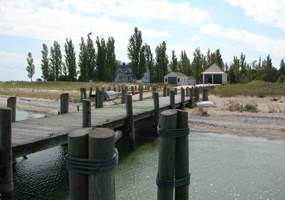
Kerry Kelly 2005 Short HikesThe VillageBe sure to take a leisurely walk through the village when you get off the ferry. The ranger station is the two story building on the left as you exit the dock. It was originally built as the home for the U.S.L.S.S. keepers and surfmen. The building was divided into two sections. The north section was for the private residence for the keeper and his family, and the south end was for the surfmen. At the rear of the building was a common area that included a kitchen. Most of the houses in the village are listed on the register of historic places. Married members of the Life-Saving Service and later the Coast Guard lived in them. Some were used as a general store or post office and homes of other islanders. Today, they are used for temporary housing for staff and volunteers. 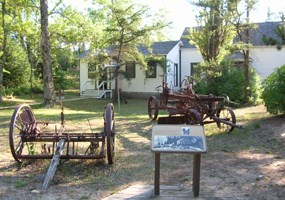
Kerry Kelly 2005 Be sure to stop by the visitor center which is housed in what used to be the island's general store. You will find a collection of historic photos and artifacts that will help you get a feeling of what life was like on the island in the past. As you look at the displays, try to imagine yourself living on the island with the people you see in the photos. The LighthouseHalf a mile hike from the village to the lighthouse. Take the boardwalk just beyond the visitor center across the sand to a great view of the lighthouse and Lake Michigan. The lighthouse was commissioned in 1872 and was the third and final Manitou Passage lighthouse. It's sleek design provides some great photographs and backdrops for snapshots of friends and family. Climb the 117 step spiral staircase to a magnificent view of the Manitou Passage, Sleeping Bear Point on the mainland and the surrounding area on the island. Learn more about the lighthouse and the keepers who operated it. 
Kerry Kelly 2005 Florence LakeFlorence Lake was named after Florence Haas (1863-1943). She served as the postmaster for the island beginning in 1912. She was also a mid-wife who delivered many of the island children and spent her later years as a crewmember on the Pere Marquette railroad carferries sailing between Michigan and Wisconsin. To hike to Florence Lake, follow the road behind the boathouse to the right past a few houses to Burdick Road. Follow Burdick Road about 1.0 mile to Ohio Road. Follow the trail straight ahead for about 0.25 miles to the sandy beach on the east side of the lake. If you want to see the north side of the lake, walk north along Ohio Road for about 10 minutes and you'll come to a trail to the left that leads to the lake. 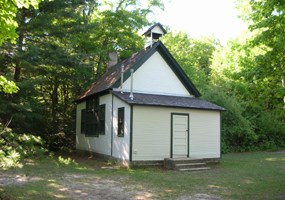
Kerry Kelly 2005 The SchoolhouseWalk another 10 minutes north on Ohio Road and you'll be at the one-room schoolhouse built in 1899. The school accommodated students from grades 1-8; those who wished to go on to high school had to go to the mainland. The teachers also served as principal, nurse, and custodian. The day typically began by cleaning the school and starting the fire to heat the building before the students arrived. The school also served as a meeting place and social activities for the island. Spelling bees, recitals, skits, and plays were held here. The CemetaryHike north of the schoolhouse on Ohio Road about a mile to the Cemetery. The cemetery is about 2 miles from the village. The island's main cemetery is preserved as the final resting place of several descendants of the island's earliest settlers. The list includes Burdick, Beck, Haas, Hutzler, and Peth. There are several other places on the island where islanders were buried. Many of them on their homesteads. Workers and transients were likely to be buried in unmarked and now forgotten graves. Longer HikesThe FarmsAt one time, there were seven successful farms on the island. You can hike the farm loop in the center of the island to see the two farmsteads that survive today. This loop is almost 2 miles around, so the total hiking distance from the village and around the loop and back is about 6 miles. 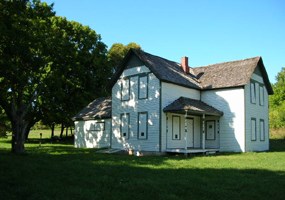
Kerry Kelly 2005 About 1/4 mile after leaving Ohio Rd, you will come to a fork in the road. If you stay to the right, the August Beck farm is the first that you will find. August was a German immigrant who came to the island as a teenager in 1860. At age 19, he married the 16 year old daughter of another German immigrant-farmer, and this became their home. He was one of the most progressive farmers on the island. Continuing down the road, you will come to the George Conrad Hutzler homestead. Hutzler was another German immigrant and half-brother to on of the island's first settlers. This farm is the place where Conrad's son and grandson, in cooperation with Michigan State, developed special highly productive varieties of rye and beans which became the standard for the industry. Conrad's grave is on the hill overlooking his homestead. 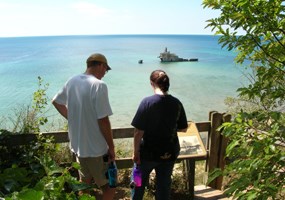
Kerry Kelly 2005 Francisco Morazan ShipwreckHike from the village to the wreck of the Francisco Morazan on the south shore of the island to see the remains of the ship, which is only partially submerged. The shipwreck is about 2.5 miles from the dock. You can either take Brudick Rd to Ohio Rd near Florence Lake and turn left to the trail, then turn right on the trail that leads to the shipwreck and the cedars. Or you can take the trail through the village and past the Weather Station campground which will continue on to the shipwreck and the cedars. When you get to the shipwreck, you will be standing on the bluff overlooking the ship. You can hear (and smell) the double-crested cormorants which now live on the ship. The Francisco Morazan left Chicago bound for Rotterdam on November 27, 1960 when it was battered by strong northwest winds the following day. Waves were washing over the decks and the crew was blinded by heavy snow squalls. Their position was off by more than 70 miles from what they thought and they ran the 246 foot freighter aground on the southern shore of South Manitou Island. The crew, captain, his wife, and unborn child were rescued, but the ship and all of the 940 ton of cargo were lost. Old Growth CedarsThe Southwestern corner of South Manitou Island is home to some of the largest white cedars in Michigan. These trees are over twice as large as the average size white cedar. The trail loops through this area, so you can get a good appreciation for the size and number of trees. It is a mystical walk. Some say that these trees were spared because their bark is infused with wind-blown sand, and the lumbermen didn't want to have to continually resharpen their saws, which they had to do by hand. This hike is about 0.3 miles beyond the turn-off to the Shipwreck of the Morazan. The Bluffs and Perched DunesThis difficult hike provides the most spectacular views of the island and is well worth the effort. You can make it to one of the highest points on the island where you can see Lake Michigan in every direction! On a clear day you can see Crescent Bay, the lighthouse, North Manitou Island, and the Sleeping Bear Dunes on the mainland. Beware of the poison ivy, which tends to grow into the trail on the dunes. 
Kerry Kelly 2005 Hiking the Beach Around the IslandThis is one of the most popular hikes on the island, but the 10-mile hike will take you quite a while, so be sure you have time to make it back to the dock before the boat leaves! Much of the shore is sandy, but there are sections that are rocky, so be sure to take your hiking shoes. You might start your hike around the island heading south of the dock and head toward Sandy Point. Just off the point lies the wreck of the Three Brothers which was grounded here in 1911. The ship lies on the steep slope just off the beach with her bow in fairly shallow water. It is a popular dive site. Follow the beach around the point and you will pass the lighthouse. Hike two more miles, and you will get a close-up eye-level view of the wreck of the Francisco Morazan. Another mile of hiking brings you to the bluffs along the beach which last about four miles along the western shore of the island. The beach here is made up of very nice sand. The Popple Campground is at the very north end of the island. This point provides a shortcut for those who want to walk back through the center of the island. If you decide to continue around the island, be sure to take the bypass around Gull Point. This short section of beach is off-limits to humans. It is a protected nesting place for the island's Herring and Ring-Billed gulls. |
Last updated: September 26, 2024
